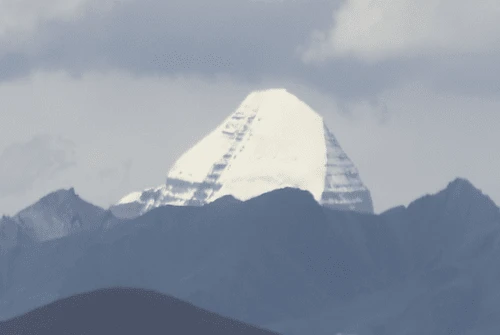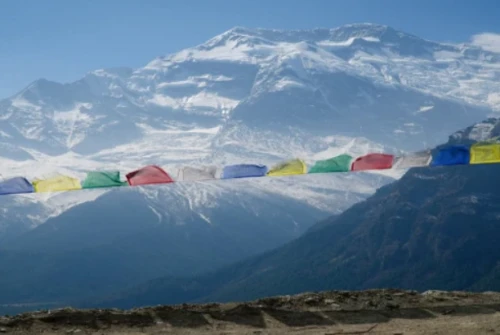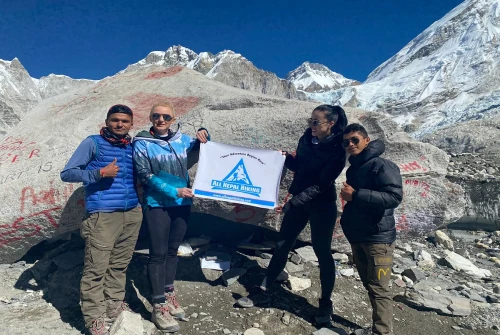Nepal is a captivating country that blends ancient history, rich cultures, and breathtaking natural beauty. It is situated between China and India and boasts diverse geographical features, including majestic snow-capped peaks, lower mountains, scenic hills, and lush plains in the Terai region. Nepal is home to a significant portion of the Himalayas, with nearly one-third of its total length and eight of the world's highest peaks located within its borders. Spanning an area of 147,516 square kilometers, the country ranges in elevation from 70 meters to the highest point at 8,848 meters above sea level. Over the years, Nepal has gained immense popularity as a tourist destination. While trekking and mountaineering have been long-standing favorites, the country offers a wide range of adventure activities that attract enthusiasts from around the world.
Nepal at a Glance: Essential Facts, Culture, and Heritage You Should Know
Official Name: Federal Democratic Republic of Nepal
Nepal, officially known as the Federal Democratic Republic of Nepal, is a landlocked nation nestled between two giant neighbors: India to the south, east, and west, and China (Tibet) to the north. This unique positioning makes it a melting pot of cultures and influences. Despite its small size, Nepal is incredibly diverse, both geographically and culturally, and continues to be a top destination for tourists seeking adventure and spiritual enlightenment.
Geography: A Land of Diversity
Nepal is home to some of the most diverse landscapes on Earth. The country stretches across 147,181 square kilometers, which includes mountainous terrain, hills, and the lowland Terai regions. At the northern border, Nepal is home to the Himalayan mountain range, which includes Mount Everest (known as Sagarmatha in Nepali) — the world’s tallest peak at 8,848 meters (29,029 feet). In contrast, the country’s southern regions feature flatlands, with the lowest point being Kechana in the Terai, at just 60 meters above sea level.
This incredible range of geography makes Nepal a prime destination for trekkers, nature enthusiasts, and wildlife lovers.
Capital: Kathmandu – A Cultural Hub
The capital of Nepal, Kathmandu, is more than just the political heart of the country; it’s a cultural and spiritual epicenter. The city is home to several UNESCO World Heritage Sites, including Kathmandu Durbar Square, Pashupatinath Temple, Boudhanath Stupa, and Swayambhunath (Monkey Temple). These landmarks not only reflect the history of Nepal but also serve as places of pilgrimage for millions of Hindus and Buddhists worldwide. Kathmandu is also known for its bustling markets, lively festivals, and traditional crafts, making it an exciting place for travelers seeking an authentic cultural experience.
Time Zone: Nepal Standard Time (NST)
Nepal operates on Nepal Standard Time (NST), which is 5 hours and 45 minutes ahead of GMT. This unique time zone means that Nepal is always ahead of most neighboring countries, including India and China. This is important for travelers to consider when planning communications or activities during their stay.
Seasons in Nepal: When to Visit
Nepal experiences four distinct seasons, each offering a different experience for travelers:
Spring (March to May): Spring is a popular time for trekking, as the weather is mild and the flowers, including the national flower Rhododendron (Laligurash), bloom across the country.
Summer (June to August): This is Nepal’s monsoon season, with heavy rains especially in the lowland and foothill areas. It’s not the best time for trekking, but a great time for cultural tourism and exploring the cities.
Autumn (September to November): This is considered the best time to visit Nepal. The weather is clear, dry, and moderate, with stunning mountain views — perfect for trekking and outdoor adventures.
Winter (December to February): While the temperatures in the mountains can drop significantly, the lowland areas offer milder conditions. Trekkers who are equipped for colder weather will find this a quieter, less-crowded season to explore Nepal’s iconic trekking routes.
Population and Ethnic Diversity
Nepal has an estimated population of 29.9 million (as of January 2023), and it’s one of the most ethnically diverse countries in the world. There are 125 different caste/ethnic groups, including Tamang, Sherpas, Gurungs, Brahmins, and Chhetris. These ethnic groups have distinct languages, customs, and ways of life, contributing to the rich cultural mosaic of Nepal.
Nepal’s official language is Nepali, but more than 123 languages are spoken across the country. This linguistic diversity adds to the unique cultural experiences available to visitors.
Currency: Nepalese Rupee (NPR)
The official currency of Nepal is the Nepalese Rupee (NPR). While major cities like Kathmandu and Pokhara have modern facilities like ATMs and credit card acceptance, it’s still a good idea to carry cash when traveling to remote areas. Visitors can exchange foreign currency at banks or money exchange counters in the cities, and local shops and markets often accept cash payments.
What to Wear in Nepal
Nepal’s varied climate means that what you wear will depend on the region and the time of year:
During the monsoon season (June to August), lightweight clothing and a raincoat or umbrella are essential.
In the winter (December to February), especially in higher altitudes, warm clothing such as jackets, thermal layers, gloves, and hats are necessary. Layering is recommended.
In the spring and autumn, lighter clothing is fine for lower altitudes, but always bring layers for mountain treks where the temperatures can fluctuate.
National Symbols: A Glimpse of Nature and Tradition
National Flower: The Rhododendron (Laligurash) is Nepal’s national flower and is found extensively in the hills and mountain regions. It blooms brightly during the spring months, covering the landscape in vibrant colors.
National Bird: The Danphe (Himalayan Monal) is the national bird of Nepal. Known for its stunning iridescent feathers, this bird can be found in the mountainous regions of the country.
National Animal: The Cow holds sacred status in Nepal and is revered in Hinduism. Cows are a significant part of Nepal’s rural economy and are often seen roaming freely.
Cultural UNESCO World Heritage Sites in Nepal
Nepal is home to a rich cultural and natural heritage, and it is recognized globally for its UNESCO World Heritage Sites. These sites reflect the country’s deep spiritual roots, centuries-old traditions, and awe-inspiring landscapes. Below is a comprehensive list of Nepal's UNESCO World Heritage Sites, both cultural and natural, that every traveler should experience.
Kathmandu Durbar Square
Located in the heart of Kathmandu, this historic square is home to several royal palaces, temples, and courtyards that date back to the Malla period. The architectural beauty and the cultural significance of this area make it one of the most important landmarks in Nepal. Key attractions include Kumari Ghar, the residence of the living goddess, and Kasthamandap, the temple that gave Kathmandu its name.Pashupatinath Temple
Situated on the banks of the Bagmati River, Pashupatinath is one of the holiest temples in Nepal and a major pilgrimage site for Hindus worldwide. The temple is dedicated to Lord Shiva and is known for its pagoda-style architecture. The temple complex includes shrines, ghats, and the sacred river, offering a serene and spiritually charged atmosphere.Boudhanath Stupa
One of the largest Stupas in the world, Boudhanath is a Tibetan Buddhist center located in Kathmandu. The stupa is surrounded by monasteries and serves as a spiritual hub for Tibetan Buddhists. The sight of the stupa’s massive mandala and the peaceful chanting of monks offers visitors a tranquil and enlightening experience.Swayambhunath Stupa (Monkey Temple)
This ancient stupa is perched atop a hill overlooking the Kathmandu Valley. Known as the Monkey Temple due to the many monkeys that inhabit the area, Swayambhunath is one of the most important pilgrimage sites for both Buddhists and Hindus. The panoramic views of the valley and the intricate paintings and statues around the stupa make it a must-visit site.Patan Durbar Square
Located in the city of Patan, this square is home to a wealth of ancient temples, shrines, and palaces. The Hiranya Varna Mahavihar and Mahabouddha Temple are notable highlights here. Patan's rich history and craftsmanship, particularly in its temples and Buddhist sculptures, are showcased beautifully in this square.Bhaktapur Durbar Square
Bhaktapur is a medieval city known for its preserved architecture and traditions. The Bhaktapur Durbar Square is home to several exquisite temples, statues, and courtyards, including Vatsala Temple and Palace of 55 Windows. This UNESCO site offers visitors a glimpse into Nepal’s artistic and cultural history.Changunarayan Temple
Located in the Bhaktapur District, Changunarayan Temple is dedicated to Lord Vishnu and is one of the oldest Hindu temples still in use. The temple, which sits atop a hill, is famous for its intricate carvings, statues, and ancient inscriptions, providing a spiritual connection to Nepal’s rich Hindu heritage.Lumbini
Lumbini, the birthplace of Lord Buddha, is one of the most sacred places for Buddhists worldwide. The site includes the Maya Devi Temple, where it is believed that Queen Maya gave birth to Siddhartha Gautama. Visitors can explore the beautiful gardens, sacred ponds, and monasteries surrounding the main temple, making Lumbini a peaceful and spiritual destination for travelers seeking enlightenment.
Natural UNESCO World Heritage Sites in Nepal
Sagarmatha National Park
Situated in the Solukhumbu District, Sagarmatha National Park is home to Mount Everest and other towering peaks of the Himalayas. A UNESCO-listed natural site, this park offers some of the world’s most spectacular trekking routes, including the famous Everest Base Camp Trek. The park is also home to rare wildlife such as the snow leopard and the red panda.Royal Chitwan National Park
Located in the southern part of Nepal, Royal Chitwan National Park is Nepal’s first national park and a UNESCO World Heritage Site. Famous for its wildlife safaris, the park is home to the endangered one-horned rhinoceros, Bengal tigers, wild elephants, and a variety of bird species. Visitors can take part in jeep safaris, canoe rides, and birdwatching excursions to explore the rich biodiversity of this park.Bardiya National Park
Though not officially recognized as a World Heritage Site, Bardiya National Park is an important wildlife sanctuary in Nepal. It is home to the rare Bengal tiger, wild elephants, and many other species of flora and fauna. Visitors often come here for an authentic jungle safari experience in Nepal’s Terai region.
Why Visit These Sites?
Nepal’s UNESCO World Heritage Sites offer travelers an opportunity to witness the spiritual, cultural, and natural beauty of the country. Whether you are interested in trekking through the high-altitude Sagarmatha National Park, exploring ancient temples and palaces in the Kathmandu Valley, or experiencing wildlife safaris in Chitwan National Park, each site provides a unique experience.
These sites not only highlight Nepal’s significance on the global cultural and natural heritage map but also reflect the deep connection of the Nepalese people to their land, history, and traditions.
Conclusion: Nepal Awaits You
Nepal, with its mesmerizing landscapes, rich history, and vibrant culture, offers a truly unique experience for travelers. Whether you’re looking for a spiritual journey, an adventurous trek, or a cultural exploration, Nepal has it all. With an increasing number of trekking tours and cultural experiences, Nepal has become a hotspot for tourists around the world.
From the majestic Himalayas to the peaceful jungles of Chitwan, Nepal promises a journey that will leave you inspired and rejuvenated. For those seeking to discover the true essence of this Himalayan kingdom, All Nepal Hiking offers a range of trekking tours, cultural visits, and community-based tourism initiatives that provide an authentic experience of Nepal.
Ready to explore Nepal? Get in touch with us to plan your unforgettable adventure in this land of mountains and mystery!




